Located along the old commercial way which crosses the city and
connects the ducal palace of Coudenberg to the Senne river, the
"Nedermerckt" (lower market) seems to be in the beginning a marshy
zone surrounded by sand banks on which little by little shops and
houses are built. 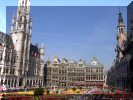 Texts from the beginning of
XIIIth century reveal the installation of a first group of buildings made up of three covered
markets (bread, cloth and meat) on the small island delimited by the place, the
herbs market, the "rue des Harengs" and the current "rue Chair
et Pain". The place is then surrounded by wooden houses and several
stone made patricians residences ("steenen"). Two of these buildings, located on the site
of the left wing of the future Town hall, are expropriated by the
Aldermen at the beginning of XIVth century in order to install there
the communal services, while the Amman, representative of the duke
of Brabant in the city, lives in a small wooden house at the angle of the
"rue de l'Etoile". Texts from the beginning of
XIIIth century reveal the installation of a first group of buildings made up of three covered
markets (bread, cloth and meat) on the small island delimited by the place, the
herbs market, the "rue des Harengs" and the current "rue Chair
et Pain". The place is then surrounded by wooden houses and several
stone made patricians residences ("steenen"). Two of these buildings, located on the site
of the left wing of the future Town hall, are expropriated by the
Aldermen at the beginning of XIVth century in order to install there
the communal services, while the Amman, representative of the duke
of Brabant in the city, lives in a small wooden house at the angle of the
"rue de l'Etoile".
In 1353, the city undertakes the construction of a new
cloth covered market on the "rue de l'Amigo", behind the
two expropriated "steenen". In spite
of the paving of the adjacent streets and the expropriation of the
houses located between the "rue de la Colline" and
"rue des Harengs" intended
to regularize the lower Market, this one is made up at that time of an
irregular juxtaposition of motley buildings often surrounded by
annexes and gardens. It will be necessary to await the beginning of XVth century to attend the aesthetic development of what became
with the course of time the principal economic and political centre of
the most important city of the Netherlands.
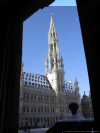 The construction of the left wing of the
Town Hall
is entrusted in 1402 to Jacques Van Thienen. The building became the symbol of the whole
population after the sharing of the power between the patricians and the trades in
1421. It is completed by
one second wing between 1444 and 1450, then by a monumental tower
from
1449 to 1454, built on the site of the antique medieval belfry by
Jan Van Ruysbroeck. The 12 feet high copper statue
representing Saint-Michael crushing the demon, realized by Martin Van Grinds, was
hauled at the top of the spire in 1454. The construction of the left wing of the
Town Hall
is entrusted in 1402 to Jacques Van Thienen. The building became the symbol of the whole
population after the sharing of the power between the patricians and the trades in
1421. It is completed by
one second wing between 1444 and 1450, then by a monumental tower
from
1449 to 1454, built on the site of the antique medieval belfry by
Jan Van Ruysbroeck. The 12 feet high copper statue
representing Saint-Michael crushing the demon, realized by Martin Van Grinds, was
hauled at the top of the spire in 1454.
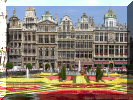 The guilds, which obtained an active participation in communal
management and see their economic power increasing thanks to the
frequent stays of the court of the dukes of Burgundy, settle quickly
around the new Town hall. The fat makers occupy "La Brouette"
(the Wheelbarrow),
the cabinetmakers and the barrel makers "Le Sac" (the Bag), the boatmen
"Le Cornet" (the Horn), the haberdashers "Le Renard" (the
Fox), the Four Crowned (sculptors, stone cutters, masons and slaters) "La
Colline" (the Hill) and the carpenters "Le Pot d'Etain" (the Pot of
Tin). The guilds, which obtained an active participation in communal
management and see their economic power increasing thanks to the
frequent stays of the court of the dukes of Burgundy, settle quickly
around the new Town hall. The fat makers occupy "La Brouette"
(the Wheelbarrow),
the cabinetmakers and the barrel makers "Le Sac" (the Bag), the boatmen
"Le Cornet" (the Horn), the haberdashers "Le Renard" (the
Fox), the Four Crowned (sculptors, stone cutters, masons and slaters) "La
Colline" (the Hill) and the carpenters "Le Pot d'Etain" (the Pot of
Tin).
Taking in hand the organization of the whole
place, the
Magistrate (the seven Aldermen) expropriates in 1441 the properties
located on the east side and, in agreement with the "Four Crowned" and
the carpenters, it makes build six identical stone houses crowned by a
continuous balustrade. The central authority
expresses its symbolic influence on the Market by making build from 1504 by Antoine
Keldermans the young a building of prestige, the House of Duke, facing the
Town hall, on the site of the old covered markets. Henri
van Pede, the architect of the Town hall of Audenarde, taken the
relay of work which was completed around 1536. When Charles Quint,
duke of Burgundy, became king of Spain, it changed name to become
the "Maison du Roi" (House of King). In 1644, the western side
of the place is equipped with new baroque facades out of stone, whereas the
north and south
sides still have a majority of small wooden houses with
Gothic, Renaissance or Baroque gables.
The 13, 14, and 15 of August 1695, a flood of fire falls down on the
centre of Brussels. This bombardment, ordered by the king of France
Louis XIV in the hope to lift the siege of the citadel of
Namur, will reduce the capital of Southern Netherlands to
the state of ruins. The French troops commanded by François de
Neufville, duke of Villeroy, Marshal of France, start the
hostilities on August 13 between six and seven o'clock in the evening
from the heights of Molenbeek. After a few hours of uninterrupted
shootings, the flames envelop the whole Grand Place and the wooden houses
which surround it. Fire spreads to the Town hall and the House
of the King around two o'clock in the morning.
When the batteries of the Marshal of Villeroy
fall silent in the middle of the day of August 15, the centre of the city is nothing
else but a gigantic blazing inferno. Located at the centre of the disaster zone, the
Grand Place is almost
completely destroyed: only remain the walls and the tower of the Town
hall - which was used as target by the French artillerists - as well
as the framework of the House of the King and the lower part of the
stone-built houses on the western side. With the exception of the
first levels of "La Brouette", "Le Sac" and
"La Louve" (the She-Wolf), the 31 houses of the place must be entirely rebuilt.
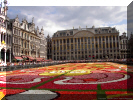 As
early as February 1696, the City approves a project of the architect
Guillaume De Bruyn who gathers under a single facade the six
properties on the east side. The series of busts of the former dukes
of Brabant placed at the first stage will give to the building its
popular name of "House
of Dukes of Brabant". A second project
of unified frontage intended for the properties located on the right
of the House of the King will not succeed, in spite of an ordinance of
April 24, 1697 which imposes a check of the facades by the
communal authorities. As
early as February 1696, the City approves a project of the architect
Guillaume De Bruyn who gathers under a single facade the six
properties on the east side. The series of busts of the former dukes
of Brabant placed at the first stage will give to the building its
popular name of "House
of Dukes of Brabant". A second project
of unified frontage intended for the properties located on the right
of the House of the King will not succeed, in spite of an ordinance of
April 24, 1697 which imposes a check of the facades by the
communal authorities.
The astonishing coherence between the Gothic Town hall and the frontages
carried out two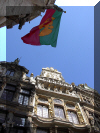 centuries and half later mark an intuitive joining
with an aesthetics which had seen the apogee of the economic power of
the guilds, and which continued to symbolize through the Town hall the autonomy of the middle-classes
towards the
totalitarian inclinations of the governor. In addition to a
verticality of Gothic inspiration, each facade develops an
exacerbated individualism which uses all the stylistic forms of the
time: Italian variations of the gables at "Le Sac",
strict use of the classical vocabulary at "La Louve", naturalism
of the Italian baroque at "Le
Cornet", French ornamentation at
"Le Renard". The only house which stands out from this aesthetics,
"Le Cygne" (the Swan), was carried out in the middle of the
guild houses by a rich foreign dealer, Pierre Fariseau. centuries and half later mark an intuitive joining
with an aesthetics which had seen the apogee of the economic power of
the guilds, and which continued to symbolize through the Town hall the autonomy of the middle-classes
towards the
totalitarian inclinations of the governor. In addition to a
verticality of Gothic inspiration, each facade develops an
exacerbated individualism which uses all the stylistic forms of the
time: Italian variations of the gables at "Le Sac",
strict use of the classical vocabulary at "La Louve", naturalism
of the Italian baroque at "Le
Cornet", French ornamentation at
"Le Renard". The only house which stands out from this aesthetics,
"Le Cygne" (the Swan), was carried out in the middle of the
guild houses by a rich foreign dealer, Pierre Fariseau.
This profusion of styles reflects less the variety of the architects than a
desire of differentiation already met in the persistence of the
individual pinion coated with eloquent signs. The sumptuous frontages
of the corporative houses contrast however with the declining economic
situation of the trades. In order to refund the colossal sums
necessary, the guilds must increase the fees and the
taxes of their members. Confronted with a free industry in full
expansion, many trades will be gradually deserted.

Nearly one century later, the integrity
of the "Gruute Met" (big market, in Brussels language) is again threatened.
On January 13,
1793, the Belgian and French Sans-culottes provide themselves with
heavy hammers and destroy all that wounds their republican
conscience: mutilated sculptures, burned paintings, plundered
silverware... No emblem of the Ancien Regime is saved. Declared
national properties, the guild houses are put on sale. The place
itself is proclaimed "Place of the People" by a decree of the 30
Ventôse An IV (1795) and a "tree of freedom" is planted on
that occasion. At the first hours of Independence, the Grand Place
became, for an extremely short time, the "Place of Regency".
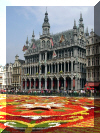 In 1852, the house "L'Etoile" is demolished to widen the street
on the left of the Town hall in order to allow the passage of a
line of tramway. It is under the impulse of the
burgomaster Charles Buls that the Grand Place will gradually recover
all its splendour. The city approves a convention which
makes it responsible for the state of the houses, in return for a
little participation of the owners in the maintenance expenses. In
1874, the old "Maison
du Roi" extremely ruined is demolished
and rebuilt by the architect Pierre-Victor Jamaer in neo-gothic
style. It shelters the City Museum since then. The other houses
owe their admirable current aspect to a full and meticulous
restoration based on the plans of the architect De Bruyn. The
principal frontage, the side walls, the tower and the galleries of the
Town hall are decorated by more than 150 statues. In 1897, "l'Etoile"
is rebuilt, narrower and with a pavement under arcades. The same year,
the 200th anniversary of the restoration of the place is celebrated
with ostentation and the old "rue de l'Etoile" is renamed
"rue Charles
Buls", in homage to the efforts made during twenty years by this
burgomaster to give back to the Grand Place its formerly splendour. Finally,
it is "Le Roy d'Espagne" which is rebuilt in 1902 on the basis of
the
original plans of Jan Cosyn. In 1852, the house "L'Etoile" is demolished to widen the street
on the left of the Town hall in order to allow the passage of a
line of tramway. It is under the impulse of the
burgomaster Charles Buls that the Grand Place will gradually recover
all its splendour. The city approves a convention which
makes it responsible for the state of the houses, in return for a
little participation of the owners in the maintenance expenses. In
1874, the old "Maison
du Roi" extremely ruined is demolished
and rebuilt by the architect Pierre-Victor Jamaer in neo-gothic
style. It shelters the City Museum since then. The other houses
owe their admirable current aspect to a full and meticulous
restoration based on the plans of the architect De Bruyn. The
principal frontage, the side walls, the tower and the galleries of the
Town hall are decorated by more than 150 statues. In 1897, "l'Etoile"
is rebuilt, narrower and with a pavement under arcades. The same year,
the 200th anniversary of the restoration of the place is celebrated
with ostentation and the old "rue de l'Etoile" is renamed
"rue Charles
Buls", in homage to the efforts made during twenty years by this
burgomaster to give back to the Grand Place its formerly splendour. Finally,
it is "Le Roy d'Espagne" which is rebuilt in 1902 on the basis of
the
original plans of Jan Cosyn.
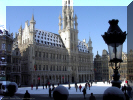 Centre of the economic life of the city, the
Grand Place was also the place
of the political assemblies, the police orders, the revolts,
the
privileges, the justice and the public festivities. In
1356, the
patrician Everard ' T Serclaes drives out there the Flemish
troops of the count Louis de Male, before being mortally wounded in
1388 by the men of the lord of Gaasbeek, to which it had been
opposed to defend the rights of his city against unjust requirements.
In 1421, Philip of Saint-Pol, regent of the Brabant States,
causes the insurrection of the trades and makes the Amman decapitate on
the place. Henri Voes and Jean Van Eschen, two monks coming from Antwerp,
climb onto the stake erected on the place on July 1, 1523, because of their conversion to the doctrines of Martin Luther. They are the first victims of the
Inquisition in the Spanish Netherlands. On June 5, 1568, in front of the current
King's House,
the counts Lamoral of Egmont and Philip of Hoorn were
decapitated by order of the duke of Alba, envoy in Brussels by the
king Philip II of Spain to fight against the Calvinists supported
by William of Nassau, Centre of the economic life of the city, the
Grand Place was also the place
of the political assemblies, the police orders, the revolts,
the
privileges, the justice and the public festivities. In
1356, the
patrician Everard ' T Serclaes drives out there the Flemish
troops of the count Louis de Male, before being mortally wounded in
1388 by the men of the lord of Gaasbeek, to which it had been
opposed to defend the rights of his city against unjust requirements.
In 1421, Philip of Saint-Pol, regent of the Brabant States,
causes the insurrection of the trades and makes the Amman decapitate on
the place. Henri Voes and Jean Van Eschen, two monks coming from Antwerp,
climb onto the stake erected on the place on July 1, 1523, because of their conversion to the doctrines of Martin Luther. They are the first victims of the
Inquisition in the Spanish Netherlands. On June 5, 1568, in front of the current
King's House,
the counts Lamoral of Egmont and Philip of Hoorn were
decapitated by order of the duke of Alba, envoy in Brussels by the
king Philip II of Spain to fight against the Calvinists supported
by William of Nassau,
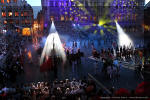 prince of Orange. Their statues erected on
the Grand Place in 1864 are today on the place of "Petit Sablon".
On September 19, 1719, it's the turn of François Anneessens to climb onto
the scaffold as main instigator of the riots. Since 1930, the place is used as
scenery by the "Ommegang",
a procession in historic costumes of the guilds and magistrates
of the city, whose remote origins go up in XIIIth century, when
the large cities of Brabant celebrated their anniversary by a
procession intended to symbolize their splendour, their manners and
their passions. prince of Orange. Their statues erected on
the Grand Place in 1864 are today on the place of "Petit Sablon".
On September 19, 1719, it's the turn of François Anneessens to climb onto
the scaffold as main instigator of the riots. Since 1930, the place is used as
scenery by the "Ommegang",
a procession in historic costumes of the guilds and magistrates
of the city, whose remote origins go up in XIIIth century, when
the large cities of Brabant celebrated their anniversary by a
procession intended to symbolize their splendour, their manners and
their passions.
On December 2, 1998, the efforts of restoration undertaken by Charles
Buls and his successors are seen rewarded by the inscription of the Grand
Place of Brussels on the
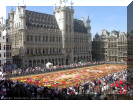 prestigious list of the World Heritage of Humanity by the Committee of UNESCO
gather in Kyoto (Japan). Today, the Grand Place became, together with
Atomium
and
Manneken Pis, one of the principal attractions of the
city of
Brussels. Every two years since 1986, the place
is covered on August 15 with a
splendid and ephemeral flowers
carpet of 1.800 square metres, made up of a million
colourful begonias, which
attracts thousands of visitors coming from the whole world. The Grand Place is also used each year as
a majestic scene for many cultural
and folk events which make of it, today like yesterday, the
favourite gathering place of the inhabitants of Brussels. A webcam
recently makes it possible to follow all that occurs there on live. prestigious list of the World Heritage of Humanity by the Committee of UNESCO
gather in Kyoto (Japan). Today, the Grand Place became, together with
Atomium
and
Manneken Pis, one of the principal attractions of the
city of
Brussels. Every two years since 1986, the place
is covered on August 15 with a
splendid and ephemeral flowers
carpet of 1.800 square metres, made up of a million
colourful begonias, which
attracts thousands of visitors coming from the whole world. The Grand Place is also used each year as
a majestic scene for many cultural
and folk events which make of it, today like yesterday, the
favourite gathering place of the inhabitants of Brussels. A webcam
recently makes it possible to follow all that occurs there on live.
|













 stadsplan
stadsplan
 mapa de
mapa de  Stadtplan
Stadtplan
 mappa di
mappa di
